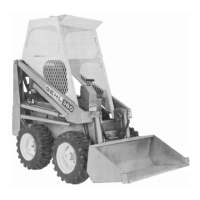4.
Move the Throttle to the Idle position.
5.
Disengage the Hydrostatic
Pump
Drive Belt Idler.
6.
Turn
the Ignition Key to "OFF" and remove the
Key.
7.
Make sure
that
all movement
and
Loader motion
has stopped, detach the Seat Belt
and
climb
out
of
the Operator's Compartment.
BEFORE STARTING THE ENGINE
Before actually starting the engine
and
running the
Loader, familiarize yourself with the T
-bar
operation
to
orient your mind
and
coordinate your
hand
movements.
Grasp the T-bars
and
move them in the
appropriate
directions
to
simulate the various movements
of
the
Loader, Load Arms and Tilt Cylinders.
STARTING THE ENGINE
I. Step up onto the back
of
the Bucket
or
Fork
and
clim
b
backwards
into
the
Operator's
Compartment.
A
WARNING: FASTEN AND PROPERLY
ADJUST the Seat Belt BEFORE proceeding.
2.
Check
that
both T-bars are in their "Neutral"
position and check
that
the Hydrostatic
Pump
Drive Belt Idler
is
disengaged.
3.
Move the Throttle to the midway point
of
its travel.
4.
F or cold engine starts, pull the
Choke
all the way
out.
5.
Turn
the Ignition Key
to
start
the
engine.
6.
Make
appropriate
Choke
readjustments
and
push
the Choke all the way in after the engine reaches
proper operating temperature.
7.
Before attempting
to
engage the Hydrostatic
Pump
Drive Belt Idler, roll the Bucket
or
Fork
back
completely
and
hold this Lift / Tilt T
-bar
position
for several seconds
to
speed-up oil heat-up process.
FIRST TIME PRACTICE RUNNING
A
WARNING:
BE
SURE that the area being
used
for test-running
is
clear of spectators
and
obstructions. Operate the Loader with
an
empty Bucket or Fork.
Smoothest and most efficient
Loader
opeation
is
achieved while the engine
is
being operated
at
half to full
Throttle. After the engine
is
sufficiently warmed-up,
engage the Hydrostatic
Pump
Drive Belt Idler
and
slowly
and deliberately move the Traction T
-bar
straight
forward, using a firm left-hand grip
and
left-arm
extension. Attempt all forward, reverse and turning
operations before proceeding to operate the Lift /Tilt T-
bar. Leaving your left hand off the Traction T-bar, slowly
and deliberately pull the
Lift/Tilt
T-bar
straight back,
using a firm right-hand grip
and
right-arm extension.
Attempt all raise and lower operations, Bucket roll-
forward
and
roll-back operations and combinations
of
the two functions before proceeding to operate
both
T-
bars at the same time.
Skill
in
Skid Steer Loader operation
is
only obtained
through proper coordination
of
the Loader's forward
and reverse travel with raising and lowering the
Load
Arms
and
with rolling the Bucket
or
Fork
forward
or
back.
To
gain proficiency, practice all
T-bar
operations
until they happen naturally and without mistake
or
hesitation.
A
WARNING: Operation
of
the Skid Steer
Loader at full Throttle should only
be
attempted after complete familiarity with all
T-bar operations
is
known. ALWAYS exercise
caution and good judgement while running this
equipment.
NOTE: To prolong Loader component life,
•
avoid "jackrabbit" starts,
stops
and
forceful
T-
bar movements.
LIFT CYLINDER LOCK (Figs. 7
&
8)
A
WARNING: When
it
becomes neccessary to
work
on
the Loader with the Load Arms
raised,
BE
SURE
to
engage the Lift Cylinder
Lock BEFORE shutting the engine off and leaving
the Operator's Compartment.
BE
SURE also
to
remove the Ignition
Key.
Fig.
7:
Lift Cylinder Lock "Engaged"
13

